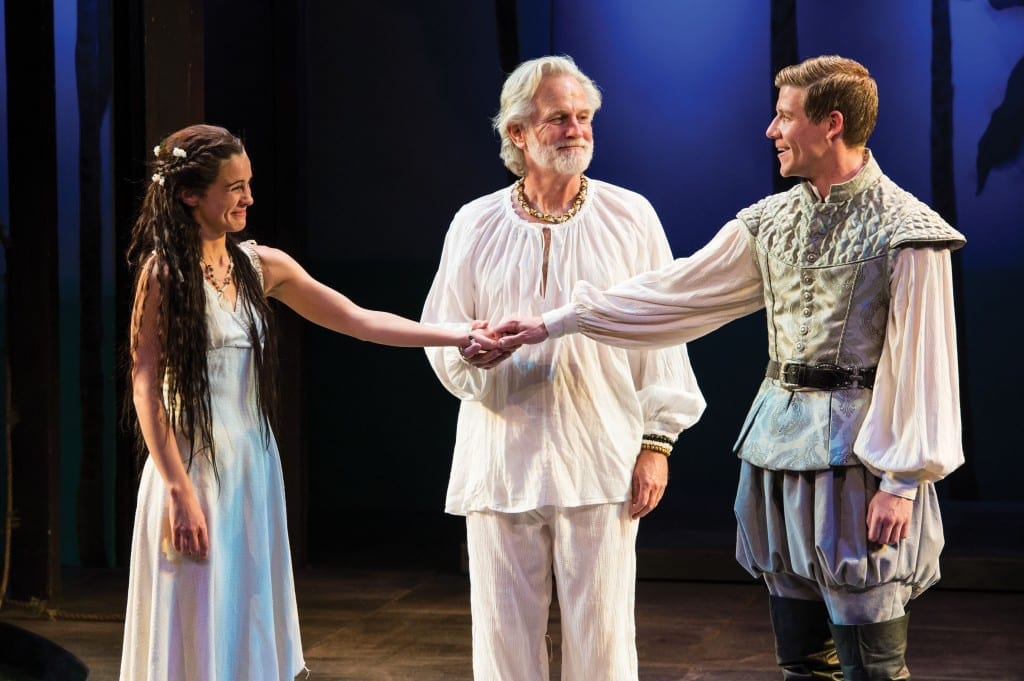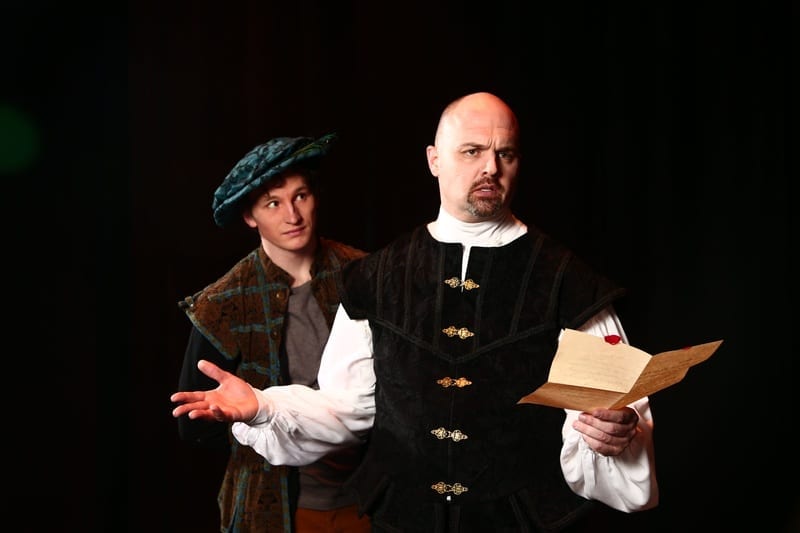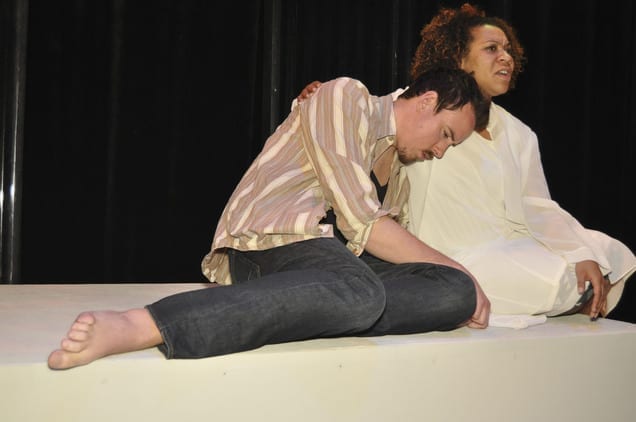CEDAR CITY — The Utah Shakespeare Festival (USF) is an incredible place to be. The caliber of talent in every element of a production leaves me in a state of awe; the passion and precision of the actors makes my mouth hang open. One of the highlights of my trip this year was seeing, hearing, and feeling USF’s Ariel, and her haunting presence on the Adams Memorial Theatre stage.

Melinda Parrett (left) as Ariel and Henry Woronicz as Prospero in Utah Shakespeare Festival’s 2013 production of The Tempest. (Photo by Karl Hugh. Copyright Utah Shakespeare Festival 2013.) Show closes August 31, 2013.
This was my maiden voyage into one of Shakespeare’s final plays. In The Tempest, Prospero is the Duke of Milan when he takes a liking to magic; it attracts much of his time and attention, so he hands some of his duke-ly duties to his brother, Antonio. But his brother decides to just take over completely. So, with help from the King of Naples, he sends Prospero (and his 3-year-old daughter Miranda) away on a broken-down ship. The two passengers land on an island, thankfully, and survive just fine. Twelve years later (when the play begins), evil brother Antonio, the King of Naples, and their shipmates are caught in a great storm, created by Prospero and his enslaved spirit Ariel; their ship is destroyed and they land on shore. Prospero uses his magic to control each character throughout the play, and ultimately, creates his ideal ending.

Corey Jones as Caliban in the Utah Shakespeare Festival’s 2013 production of The Tempest. (Photo by Karl Hugh. Copyright Utah Shakespeare Festival 2013.)
Admittedly traumatized by USF’s production of Titus Andronicus last year, I was thrilled to see Jeb Burris and Melisa Pereyra in more comforting roles. Burris plays Ferdinand, the son of the King, and he personifies a noble prince and a man in love. The way he looked at Pereyra was addictive; their scenes were never long enough for me. Pereyra was so fresh, so endearing, as Prospero’s daughter Miranda. I was completely pulled in by her concern for the men on the boat, her excitement at meeting a man, and the way she loved her father. Burris and Pereyra are incredibly talented, versatile actors.
I’ve stated that Ariel was amazing. After this introduction to the character, I fear I will never find another Ariel as divine as Melinda Parrett. She asks Prospero, “Dost thou love me master?” in such a sincere way. I found this moment/concept fascinating, as I did later, during their sweet goodbye. Parrett’s singing was beautiful; every movement of her body was majestic. She was soothing and startling, perfection from her fingertips to her pointed toes. As a choreographer, Stephanie Ivers absolutely presented magic on that stage, and I was lucky enough to witness it.

James Newcomb (left) as Stephano and Roderick Peeples as Trinculo in the Utah Shakespeare Festival’s 2013 production of The Tempest. (Photo by Karl Hugh. Copyright Utah Shakespeare Festival 2013.)
When Prospero (Henry Woronicz) was using his art (magic), I noticed Woronicz’s hands, his presence, and his movements. Never overdoing it, Woronicz clearly showed that Prospero was a powerful man. The effect of his magic was always synchronized with the other actors, the lighting, and the sound; it was impressive. Waronicz bringing Jeb Burris to his knees was one great example of how connected the actors on stage were to one another. I also loved the relationship between Prospero and Miranda, “A cherubim thou wast.” He was so tender with her. When he presents his backstory to her, it could have been so boring, but Woronicz never lost my attention.
Each human character in the show was dressed in black, white, or grey. That neutral canvas helped make Caliban and Ariel stand out in their detailed costumes and artistic makeup. I liked Prospero and Miranda’s costumes (designed by David Kay Mickelsen) very much, and the style of their hair. The other spirits were dressed like Ariel, but had no faces. I was put-off by that, and by the masks that the other spirits wore later in the play. But in general, Mickelsen’s costume work was impressive. Ariel had lights in her fingers, for goodness sake!
It was a hot night in Cedar City, but I could forget that, as the music and sounds in the Adams surrounded the audience: echoing, blowing, and moving. Composer and sound designer Joe Payne created a beautiful audio environment, writing melodies to fit Shakespeare’s text. There were many stunning lighting moments, too, by Donna Ruzika. When Ariel scares the group of wandering men, the lights against the leaves she wore made her so beautiful and fierce. Finally, director B. J. Jones crafted an amazing “wedding” ceremony by the spirits. The human beings showed so much love, the three singers (Kaitlin Margaret Mills, Melissa Graves, and Cate Cozzens) were enchanting; visually, too, I loved that scene so much.
A part of me wished Prospero had been more compassionate to Caliban. Even though the servant had tried to make Caliban babies with Miranda, it was still tough for me to see him treated so badly. Corey Jones portrayed Caliban in a way that I pitied him; he was creepy, slimy, and scary, but also sort of likeable in the way he shrank from punishment. When Caliban was with Stephano, drinking wine and feeling hope, I was very glad as well. It was fun when they danced around and sang, “Ban, ban, Caliban.”
I adored James Newcomb as the drunken Stephano and enjoyed his singing entrance. Newcomb had a delightful way of speaking and such wonderful words from Shakespeare, like “mooncalf” and “servant monster.” Stephano was one of the characters to address the audience, and did so naturally. Roderick Peeples played Stephano’s companion Trinculo, who wasn’t as funny as I would like a Shakespearean fool to be; rather Stephano seemed to be the straight man to Newcomb’s jokes.
I did get bored in the show a few times when a monologue or two seemed to drag on. During the scenes with the King and his companions, there were lines I couldn’t catch, and not enough going on to really interest me. But the flaws are few compared to the artistry of the Utah Shakespeare Festival. I congratulate the cast and crew for the product they have delivered, and will be delivering all summer long. I think The Tempest is a play for everyone; it’s a love story with magic and spirits set on a tropical island. I hope my senses will hang on to this show for a long time.







